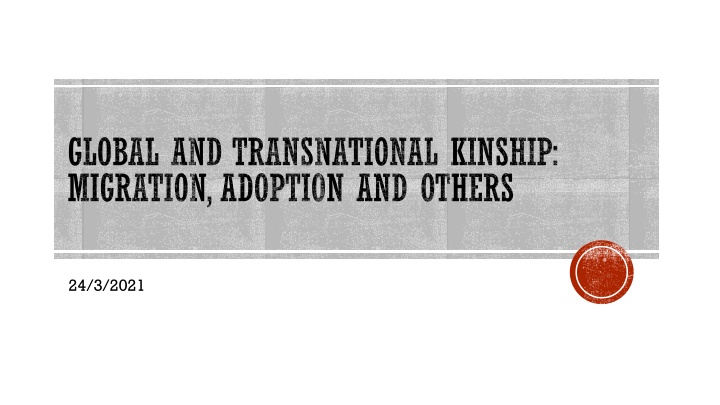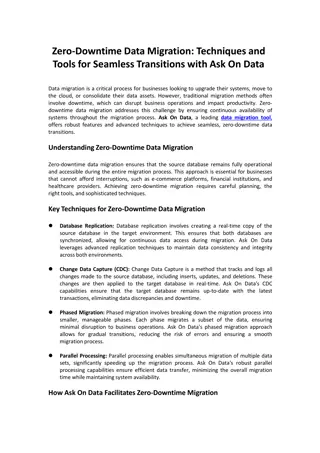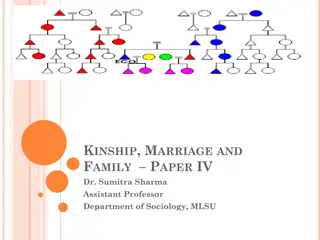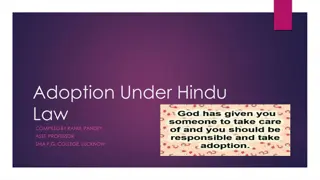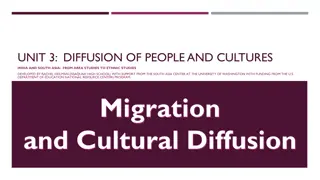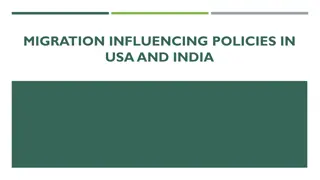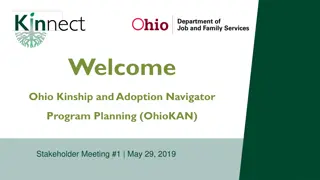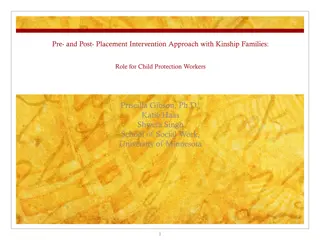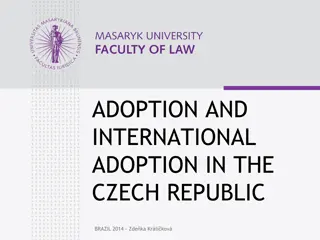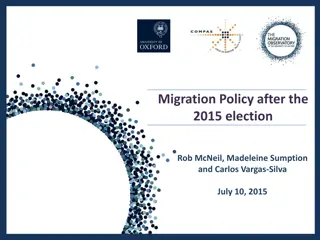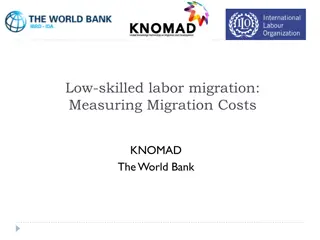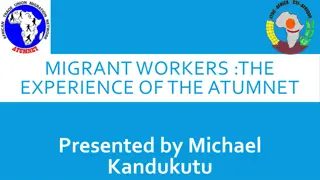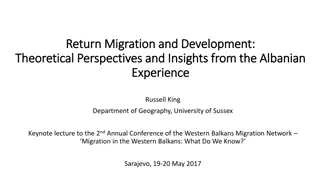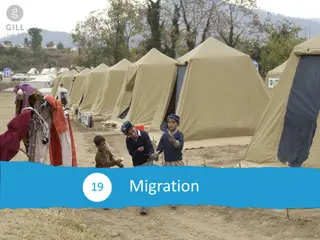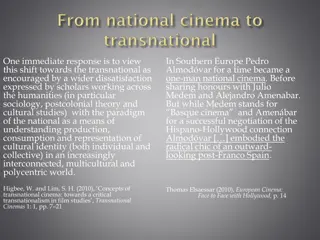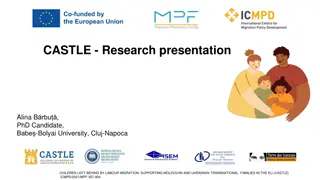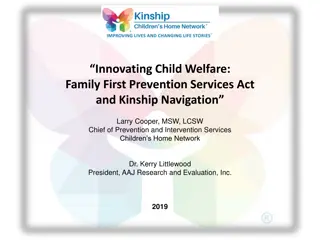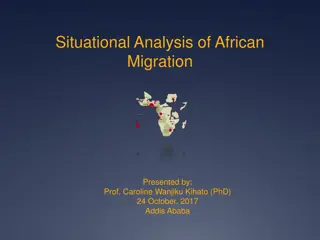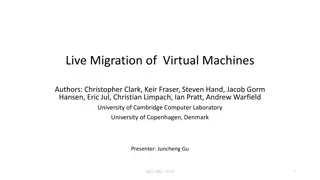Global and Transnational Kinship: Migration, Adoption, and Others
Explore the complexities of global and transnational kinship through narratives of Vietnamese individuals navigating relationships with Czech and Vietnamese grandmothers. These stories highlight feelings of belonging, identity, and cultural connections in the context of migration and family ties.
Download Presentation

Please find below an Image/Link to download the presentation.
The content on the website is provided AS IS for your information and personal use only. It may not be sold, licensed, or shared on other websites without obtaining consent from the author.If you encounter any issues during the download, it is possible that the publisher has removed the file from their server.
You are allowed to download the files provided on this website for personal or commercial use, subject to the condition that they are used lawfully. All files are the property of their respective owners.
The content on the website is provided AS IS for your information and personal use only. It may not be sold, licensed, or shared on other websites without obtaining consent from the author.
E N D
Presentation Transcript
GLOBAL AND TRANSNATIONAL KINSHIP: MIGRATION, ADOPTION AND OTHERS 24/3/2021
OUTLINE Vietnamese second generation caring, kinning, belonging Families and migration: case of kin work Transnational families: transnational motherhood, transnational fatherhood Kinning and discussion
KINNING WITH CZECH GRANDMOTHERS
KINNING WITH CZECH GRANDMOTHERS I was six or seven years old and when I went somewhere, I went there with my granny. And I told everyone around that she is my granny. The children told me she could not be my granny because we are not alike. Then I was crying a lot and I kept on saying that she was my granny. My parents had to explain to me that she is not my granny and that she only looks after me and that my grannies were in Vietnam. And those days I was split because I told them the grannies in Vietnam are not my grannies because they never looked after me, they have never been with me and they have never spent time with me. They even do not know what I like! When we visited Aunt Jana [her nanny s daughter], it was automatic that I said hello to her and went to the room to play with their children. And we went together to the cemetery and I was curious about who this and that was. And my granny told me, This is great grandmother. And I said Wow, really? Then I came home and told my mum that our great grandmother is there in the cemetery. Khanh, 21-year-old woman, in CR since the age of four
KINNING WITH VIETNAMESE GRANDMOTHERS
KINNING WITH VIETNAMESE GRANDMOTHERS Well it was very weird because I went there and my mum told me who we were going to see. I did not know these people, they were strangers to me. Then we came to a village where my grandmother, my mother s mother, lived. There suddenly a woman took my hand and she was pulling me inside and she was so happy and excited. But I did not know her at all. And she started squeezing my bones, I think she wanted to make sure that I was real or healthy or I don t know. Something like that. So it was interesting. Then after a few minutes or a couple of days maybe I felt the warmth of home, that they were my relatives and my family. Tuyet, 21-year-old, born in Vietnam
KINNING AND BELONGING two types of stories about belonging through kinship, as there are two different mechanisms of kinning I can say that she gave me a home then. Now she cannot give it to me anymore because I think differently about things. But before she was simply my home. Because of her I did not want to leave the Czech Republic. You know, not because of my friends or the teachers at school that I liked, but because of my granny. Because my granny was here for me she was home for me.(Hanh, 18-year-old woman born in the Czech Republic) I was like a tourist in my own country. I still take Vietnam as an important part of my life. It is something from my past, but it is not finished; the relationship still persists in myself, in my interaction with people, with my family. (Thi, 21-year-old woman born in Vietnam) Emotional/symbolic transnationalism Transnational grandchildhood routes and roots
TWO STORIES ABOUT BELONGING STORY 1 Vietnam Vietnamese granny heritage from parents ancestry physical appearance (race, banana kids ) blood, genes mother s or father s mother genealogy common blood shared genes the relationship that simply is (taken for granted), it is stable, undeniable and unchabgeable; naturalization of homelad Le Espiritu (2003): many migrants articulate their sense of home by overemphasizing ties of biology and geografy
TWO STORIES ABOUT BELONGING STORY 2 Czech Republic Czech granny country of growing up and/or birth education common cultural memory (language, history ) friends all I created here experiences time spent together doing things a la Czech relationship that is negotiated
MIGRATION AND FAMILIES: KIN WORK
KINSHIP NEW APPROACHES Schneider (1970s): kinship as a system of relationships is freed from presuming that the relationships are first of all genealogical and reproductive and, instead, considers the relationships as they are culturally specified, both in terms of the structural form of the system of symbols through which the relationships are expressed and the "meaning" of those symbols Sahlins (2011): performative kinship kinship is in this way the perduring condition of the possibility of its (unstable) practice whatever is construed genealogically may also be constructed socially the existing relations between persons are potentially unstable: continuously vulnerable to events and ever subject to negotiation Carsten (2000s) broken and reconstituted families, new technologies What is after kinship ? kinship as it is made in shared experience, and interwoven with concepts of the house, person, gender, nationality, and new technologies.
MICAELA DI LEONARDO: Micaela di Leonardo, 1987. The Female World of Cards and Holidays: Women, Families, and the Work of Kinship. Signs, Vol. 12, No. 3., pp. 440-453. KIN WORK
MICAELA DI LEONARDO: KIN WORK CONCEPTUALIZATION Research on Italian Americans Women do: housework and child care, work in the labor market, and the work of kinship. What is kin work? By kin work I refer to the conception, maintenance, and ritual celebration of cross-household kin ties, including visits, letters, telephone calls,presents, and cards to kin; the organization of holiday gatherings; the creation and maintenance of quasi-kin relations; decisions to neglect or to intensify particular ties; the mental work of reflection about all these activities; and the creation and communication of altering images of family and kin vis-a-vis the images of others, both folk and mass media. (p. 441-442)
MICAELA DI LEONARDO: KIN WORK EXAMPLES Kin work = female work kin contact and holiday celebration depend on the presence of an adult woman in the household. When couples divorced or mothers died, the work of kinship was left undone; when women entered into sanctioned sexual or marital relationships with men in these situations,they reconstituted the men's kinship networks and organized gatherings and holiday celebrations women, as the workers in this arena, generally had much greater kin knowledge than did their husbands, often including more accurate and extensive knowledge of their husbands' families
Nick: My grandfather was a very outspoken man, and it was reported he took off for the hills when he found out that Mussolini was in power. Pina: And he was a very tall man; he used to have to bow his head to get inside doors. Nick: No, that was my uncle. Pina: Your grandfather too, I've heard your mother say. Nick: My mother has a sister and a brother. Pina: Two sisters! Nick: You're right! Pina: Maria and Angelina. Kin work = female work kin contact and holiday celebration depend on the presence of an adult woman in the household. When couples divorced or mothers died, the work of kinship was left undone; when women entered into sanctioned sexual or marital relationships with men in these situations,they reconstituted the men's kinship networks and organized gatherings and holiday celebrations women, as the workers in this arena, generally had much greater kin knowledge than did their husbands, often including more accurate and extensive knowledge of their husbands' families MICAELA DI LEONARDO KIN WORK EXAMPLES
TRANSNATIONAL(?) FAMILIES(?) How can we define transnational families? What is transnational about them? What does make them families? How are they created and maintained?
TRANSNATIONAL FAMILIES caring across borders (child care, elderly care) the provenance of most everyday migrant transnationalism is within families family support, intergenerational solidarity doing family polymedia (FB or Skype? Skype or SMS? SMS or call? Call or e-mail?...) proximity at distance but not distant proximity?
TRANSNATIONAL MOTHERHOOD The ground-breaking concept developed by Avila and Hondagneu-Sotelo in 1997 "I'm Here, but I'm There": The Meanings of Latina Transnational Motherhood mothering practices among Latina migrant mothers in the USA Contexts and contradictions of motherhood the circuits of affection, caring, and financial support that transcend national borders
TRANSNATIONAL MOTHERHOOD As a result of feminization of migration New family arrangements when mothers migrate without their children (note: when fathers migrate, there is no pressure to develop any new concept) Raised questions: How do mothers accomplish the normative expectations connected with their role of mothers? How they negotiate their motherhood at distance? How do they deal with the feeling of guilt?
TRANSNATIONAL MOTHERHOOD Added value of the concept Contribution to the theoretical debates on moterhood and diversity of motherhood practices Including breadwinning as a part of mothering De-biologization and de-essentialization of motherhood?
TRANSNATIONAL FATHERHOOD The notion appears ten years after the notion of transnational motherhood (Pribilsky 2007, Parre as 2008) Engendering the men s exprience with migration took time and the research on the transnational fathering practices is still marginalized Researchers have shown little interest in how men perform their fathering roles when they are separated from their families due to migration. Kilkey et al. (2014, p. 178) argue that such neglect is increasingly problematic in the context of rising social, political and academic interest in the significance of fathering in European (and other) societies.
TRANSNATIONAL FATHERHOOD Hibbins and Pease (2009, p. 5) comment on the research on migration and masculinity as follows: it is understandable that the feminist literature is concerned with women s experiences of migration, which gender-neutral models of migration have neglected. However, gender neutrality has meant that both genders experiences have been ignored. While traditional immigration research has predominantly focused on men, it has done so by examining men as non-gendered humans and it too has ignored gendered dimensions of men s experiences. From male-biased research on migration and family to women- only focus in social science?
THREE STAGES IN TRANSNATIONAL FATHERHOOD RESEARCH 1. Discovery of unseen transnational fatherhood, 2. Conceptualization of breadwinning transnational fatherhood, and 3. Shift to conception of caring transnational fatherhood.
DISCOVERY OF UNSEEN TRANSNATIONAL FATHERHOOD intensive research interest in transnational motherhood practices and disregard of the fathering experience of migrant men. When the male migrants experience is addressed, it is only with the stress on their role as breadwinners (not fathers explicitely). Ten years after the notion of transnational motherhood came to light, Pribilsky remarked on the neglect of the fathering experience of migrant men, asking why researchers speak of transnational families only when looking at women s role (Pribilsky, 2007, p. 278). Avila and Hondagneu-Sotelo (1997, p. 552) argue: When men come north and leave their families in Mexico (...) they are fulfilling familial obligations defined as breadwinning for the family. When women do so, they are embarking not only on an immigration journey but on a more radical gender-transformative odyssey.
CONCEPTUALIZATION OF BREADWINNING TRANSNATIONAL FATHERHOOD the differences between transnational motherhood and transnational fatherhood Caregiving versus breadwinning Dreby (2006): Fathers believe that an honorable way to provide for their families is to migrate to the USA where they earn more for their labor. Mexican mother s morality is tied to how well they care for their children. Zentgraf and Chinchilla (2012): Migrant fathers relationships to their children in Mexico are typically shaped by their economic success and a desire to maintain some degree of authority, while those of migrant mothers are focused on demonstrating emotional intimacy from a distance. Pink-blue world of gendered expectations and its inscription into how we as researchers see the reality around us
SHIFT TO CONCEPTION OF CARING TRANSNATIONAL FATHERHOOD Making men into fathers, making fathers into caring fathers, from cash to care Schmalzbauer s (2015): The expectations surrounding the emotional labour of transnational fathers are less clear. Because fatherhood tends to be constructed around provision and authority, there is no cultural script for how fathers should maintain an emotional connection with children in the context of family separation. It is thus not surprising that transnational family researchers have found experiences of fatherhood to be more varied than those of motherhood.
KINNING the process by which a foetus or new-born child (or a previously unconnected person) is brought into a significant and permanent relationship with a group of people that is expressed in a kin idiom (Howell 2003: 465) kinship is something that is necessarily achieved in and through relationships with others The social dimension of kinship creates continuity over time and gives people a sense of belonging to a life to something bigger than the individual to kin is a universal process, marked in all societies by various rites of passage (...) but it has not generally been recognized as such.
